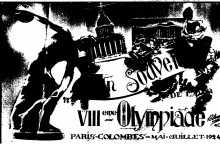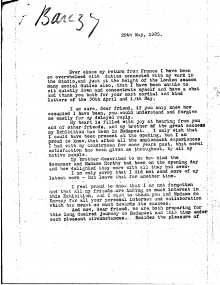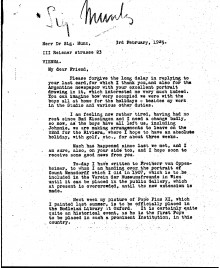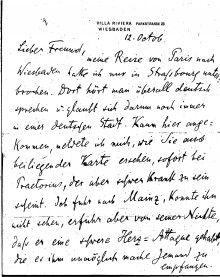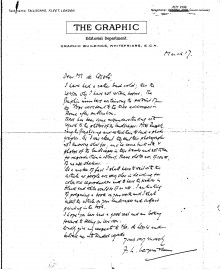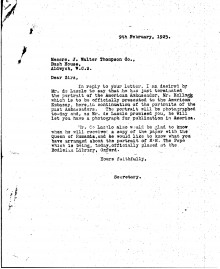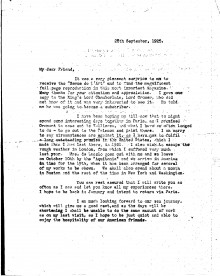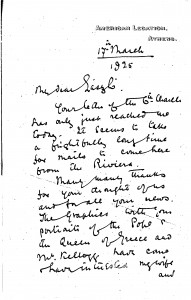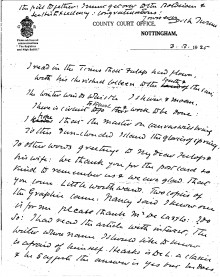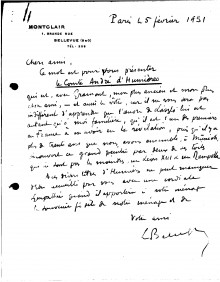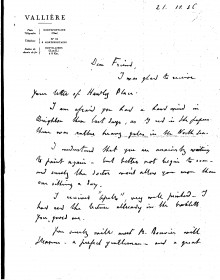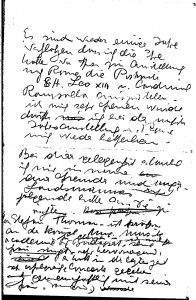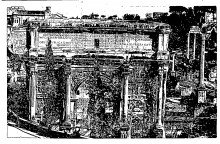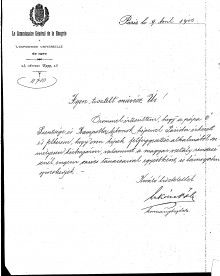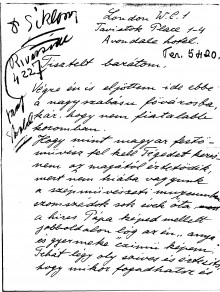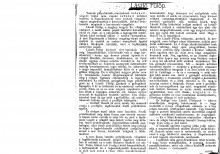-
Sender: Gramont, Duchesse de [née Elaine Hélène de Greffulhe]; wife of 12th duc (1882 - 1958)
Recipient: László, Philip Alexius de (1869 - 1937)
Postcard from the duchesse de Gramont regarding photographs of the Queen [possibly 3200] and Pope [possibly 6690]. She notes that everyone is talking about the success of de László's exhibition at the French Gallery (item was previously archived with DLA015-0075)
-
Sender: László, Philip Alexius de (1869 - 1937)
Recipient: Bárczy de Bárcziháza, István (1882 - 1952)
De László has been busy recently. He was delighted to hear about the success of his exhibition in Budapest and that he has not been forgotten; he is preparing for his trip there and asks Bárczy to arrange various engagements. He hopes a decision has been taken regarding the Art Society prize. He includes details of recent/current sitters [6762] [3491] and presentations at Cambridge [2458] [2456] and Oxford [6690]. He suggests Bárczy writes his own memoirs
-
Sender: László, Philip Alexius de (1869 - 1937)
Recipient: Münz, Sigmund (1859 - 1934)
Letter from de László to Sigmund Münz regarding travel plans & recent work. Count Mensdorff's portrait [4694] will go to Verein der Museumsfreunde; Pope Pius XI's portrait [6690] to be officially placed in Bodleian; painting Ambassador Kellogg [5917], mentioning recent Pilgrims' Club dinner. Crown Prince of Romania wants him to paint Crown Princess; has refused overtures to paint King & Queen of Romania. Dining with French Ambassador & Prince of Liechtenstein
-
Sender: Münz, Sigmund (1859 - 1934)
Recipient: László, Philip Alexius de (1869 - 1937)
Sigmund Münz tried to contact Wilhelm Preetorius in Mainz; was told he was very ill. Mainz is biggest French garrison town Münz has ever seen; people aren’t happy with colonial troops there. Asks de László to send photos of portraits (Mussolini [6383], Tittoni [7347], Pope [6690], Queens of Romania [3200] & Greece [3273]) for “Nación” article. Thanks de László for help in Paris. Met Count Merenberg, heard much about miserable Russian situation
-
Sender: Leipnik, Doctor Ferdinand L. (1869),László, Philip Alexius de (1869 - 1937)
Recipient: László, Philip Alexius de (1869 - 1937)
Ferdinand L. Leipnik sends a copy of "The Graphic" (21 February 1925 issue) containing reproductions of Pope Pius XI [6690] and Frank Billings Kellogg [5917] to de László
-
Sender: Leipnik, Doctor Ferdinand L. (1869)
Recipient: László, Philip Alexius de (1869 - 1937)
Ferdinand L. Leipnik informs de László that issues of "The Graphic" containing the Pope's portrait [6690] have been sent to Rome. He mentions a misunderstanding regarding photography of the landscapes. Leipnik is thinking of writing a book on de László and will insert the article on the landscapes and subject painting therein
-
Sender: László, Philip Alexius de (1869 - 1937)
Recipient: J. Walter Thompson Company
Letter to the advertising agency, J. Walter Thompson Co. De László has finished the portrait of the American Ambassador [5917] and will send a photograph to the agency for publication in America. He requests a copy of the paper with the portrait of Queen Marie of Romania [3200] and asks what has been arranged for his portrait of the Pope [6690]
-
Sender: J. Walter Thompson Company
Recipient: László, Philip Alexius de (1869 - 1937)
Letter from J. Walter Thompson Co. advertising agency advising that de László allows his portrait of Pope Pius XI [6690] to be reproduced in national newspapers in America. This would secure valuable publicity ahead of his forthcoming trip to America. Their New York office has lined up the newspapers and obtained consent from publishers
-
Sender: J. Walter Thompson Company
Recipient: László, Philip Alexius de (1869 - 1937)
Letter from J. Walter Thompson Co. advertising agency to de László regarding reproduction of his portrait of Pope Pius XI [6690] in New York. They thank the artist for the prints of the Queen of Romania's portrait [3200]
-
Sender: László, Philip Alexius de (1869 - 1937)
Letter from de László thanking the unidentified recipient for a copy of the "Revue de l'art", which included his portrait of Pope XI [6690]. De László had hoped to travel to Paris to paint the Trianon, but must go to America. He asks the recipient's view on holding an exhibition in October or November, 1926
-
Sender: Laughlin, Irwin Boyle (1871-1941)
Recipient: László, Philip Alexius de (1869 - 1937)
Irwin Boyle Laughlin thanks de László for "The Graphic" containing portraits [6690] [5917] [3273]; Queen Elisabeta's left him "quite cold". Mentions Gennadius' portrait [5316] and describes that sitter's character and his library under construction in Athens. When de László goes to America he should visit his Meridien House. Describes Greece as "falling to pieces"
-
-
Sender: László, Philip Alexius de (1869 - 1937)
Recipient: Siklóssy de Pernesz, Doctor László (1881 - 1951)
De László is pleased his sketch of Siklóssy [111404] was well received. Discusses the restoration and exhibition of his portraits of Wekerle [possibly 111100] and Horthy [110886]. Mentions a new commission to paint Elemér Preszly. Expresses continued desire to paint Légrády and Herczeg's portraits. Shares autobiographical notes for a proposed Hungarian edition of "Painting a Portrait", recounting early artistic ambitions and career milestones. Asks for help locating a picture [6316] he donated to charity and which remains unaccounted for.
-
Sender: Gramont, Antoine XII-Armand, 12th duc de; styled duc de Guiche (1879 - 1962)
Recipient: László, Philip Alexius de (1869 - 1937)
Advises de László to rest before returning to paint. Reference to the artist's lecture reprinted in "Apollo". The Comtesse de Mun has seen some pictures of de László's, including the Pope, and Gramont's son saw his portrait in Florence [9724].
-
Sender: László, Philip Alexius de (1869 - 1937)
Recipient: Unidentified
De László expresses a desire to participate in the upcoming Rome exhibition, having previously exhibited portraits of Pope Leo XIII [4509] and Cardinal Rampolla [4511]. He introduces his friend, István Thoman, Professor at the Academy of Music in Budapest, and Thoman’s wife, a talented singer.
-
Sender: Senyei, József (1895 - 1944)
Recipient: László, Philip Alexius de (1869 - 1937),Pius XI, Pope, né Achille Ambrogio Damiano Ratti (1857 - 1939)
Senyei sends his greetings from Rome, where he has painted the Pope. He also had a commission to paint Mussolini, but this has had to be postponed as he is not sitting to anybody at present.
-
Sender: Lukács, Béla (1847 - 1901)
Recipient: László, Philip Alexius de (1869 - 1937)
Béla Lukács, Hungarian Government Commissioner at the Exposition Universelle in Paris, asks for de László's assistance in the hanging of the artist's portraits of Pope Leo XIII [4509] and Cardinal Rampolla [4511], and for his assistance more generally with curating the Hungarian section of the Exposition.
-
21 to 40 of 78 Archives

